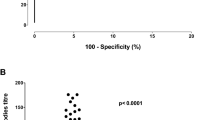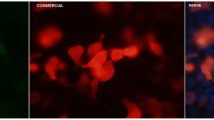Abstract
Objectives
Anti-myelin-associated glycoprotein (MAG) antibody is associated with clinically heterogeneous polyneuropathies. Our purpose was to compare neuropathy phenotypes identified by different anti-MAG tests’ results.
Methods
Cohort study: Sera from 40 neuropathy anti-MAG EIA positive patients were tested for anti-MAG by Western blot (WB), for anti-peripheral nerve myelin (PNM) on monkey nerve by immunofluorescence assay (IFA), and for anti-HNK1 on rat CNS slices by IFA. Anti-sulfatide antibodies, for comparison, were also tested by EIA.
Results
Among 40 anti-MAG EIA positive sera, 85% also had anti-PNM IFA reactivity and 67.5% bind HNK1 on rat CNS. Anti-HNK1 positive patients had the classical predominantly distal acquired demyelinating symmetric (DADS) neuropathy with a benign course, while anti-PNM positive but anti-HNK1 negative patients had predominantly axonal neuropathy with a high frequency of anti-sulfatide reactivity and the worst long-term prognosis. Anti-MAG EIA positive patients without anti-PNM or anti-HNK1 IFA reactivity had a CIDP-like polyneuropathy.
Conclusion
Different methods to test for anti-MAG antibodies identify different clinical and electrophysiological findings, as well as long-term outcome. HNK1 reactivity is the strongest marker of DADS.

Similar content being viewed by others
Abbreviations
- MAG:
-
Myelin-associated glycoprotein
- EIA:
-
Enzyme immunosorbent assay
- IFA:
-
Immunofluorescence assay
- WB:
-
Western blot
- HNK1:
-
Human natural killer-1
- DADS:
-
Distal acquired demyelinating symmetric neuropathy
- CIDP:
-
Chronic inflammatory demyelinating polyneuropathy
- PNM:
-
Peripheral nerve myelin
- SGPG:
-
Sulfate-3-glucuronyl paragloboside
- mRD:
-
Modified Rankin disease
- IVIg:
-
Intravenous immunoglobulin
- PE:
-
Plasma exchange
- MCV:
-
Motor conduction velocity
- DL:
-
Distal latency
- CMAP:
-
Compound motor action potential
- SCV:
-
Sensory conduction velocity
- SNAP:
-
Sensory nerve action potential
References
Nobile-Orazio E, Marmiroli P, Baldini L, Spagnol G, Barbieri S, Moggio M, Polli N, Polli E, Scarlato G (1987) Peripheral neuropathy in macroglobulinemia: incidence and antigen-specificity of M proteins. Neurology 37:1506–1514
Latov N, Hays AP, Sherman WH (1988) Peripheral neuropathy and anti-MAG antibodies. Crit Rev Neurobiol 3:301–332
Erb S, Ferracin F, Fuhr P, Rosler KM, Hess CW, Kuntzer T et al (2000) Polyneuropathy attributes: a comparison between patients with anti-MAG and anti-sulfatide antibodies. J Neurol 247:767–772
Capasso M, Torrieri F, Di Muzio A, De Angelis MV, Lugaresi A, Uncini A (2002) Can electrophysiology differentiate polyneuropathy with anti-MAG/SGPG antibodies from chronic inflammatory demyelinating polyneuropathy? Clin Neurophysiol 113:346–353
Ellie E, Vital A, Steck A, Boiron JM, Vital C, Julien J (1996) Neuropathy associated with “benign” anti-myelin-associated glycoprotein IgM gammopathy: clinical, immunological, neurophysiological pathological findings and response to treatment in 33 cases. J Neurol 243:34–43
Fluri F, Ferracin F, Erne B, Steck AJ (2003) Microheterogeneity of anti-myelin-associated glycoprotein antibodies. J Neurol Sci 207:43–49
Gorson KC, Ropper AH, Weinberg DH, Weinstein R (2001) Treatment experience in patients with anti-myelin-associated glycoprotein neuropathy. Muscle Nerve 24:778–786
Weiss MD, Dalakas MC, Lauter CJ, Willison HJ, Quarles RH (1999) Variability in the binding of anti-MAG and anti-SGPG antibodies to target antigens in demyelinating neuropathy and IgM paraproteinemia. J Neuroimmunol 95:174–184
Kawagashira Y, Kondo N, Atsuta N, Iijima M, Koike H, Katsuno M, Tanaka F, Kusunoki S, Sobue G (2010) IgM MGUS anti-MAG neuropathy with predominant muscle weakness and extensive muscle atrophy. Muscle Nerve 42:433–435
Magy L, Kaboré R, Mathis S, Lebeau P, Ghorab K, Caudie C et al (2015) Heterogeneity of polyneuropathy associated with anti-MAG antibodies. J Immunol Res 2015:450391
Jaskowski TD, Prince HE, Greer RW, Litwin CM, Hill HR (2007) Further comparisons of assays for detecting MAG IgM autoantibodies. J Neuroimmunol 187:175–178
Kuijf ML, Eurelings M, Tio-Gillen AP, van Doorn PA, van den Berg LH, Hooijkaas H, Stork J, Notermans NC, Jacobs BC (2009) Detection of anti-MAG antibodies in polyneuropathy associated with IgM monoclonal gammopathy. Neurology 73:688–695
Pestronk A, Li F, Griffin J, Feldman EL, Cornblath D, Trotter J, Zhu S, Yee WC, Phillips D, Peeples DM (1991) Polyneuropathy syndromes associated with serum antibodies to sulfatide and myelin-associated glycoprotein. Neurology 41:357–362
Ilyas AA, Cook SD, Dalakas MC, Mithen FA (1992) Anti-MAG IgM paraproteins from some patients with polyneuropathy associated with IgM paraproteinemia also react with sulfatide. J Neuroimmunol 37:85–92
Ilyas AA, Dalakas MC, Brady RO, Quarles RH (1986) Sulfated glucuronyl glycolipids reacting with anti-myelin-associated glycoprotein monoclonal antibodies including IgM paraproteins in neuropathy: species distribution and partial characterization of epitopes. Brain Res 385:1–9
Nobile-Orazio E, Giannotta C (2011) Testing for anti-glycolipid IgM antibodies in chronic immune-mediated demyelinating neuropathies. J Peripher Nerv Syst 16(Suppl 1):18–23
Van den Berg L, Hays AP, Nobile-Orazio E, Kinsella LJ, Manfredini E, Corbo M et al (1996) Anti-MAG and anti-SGPG antibodies in neuropathy. Muscle Nerve 19:637–643
Matà S, Ambrosini S, Mello T, Lolli F, Minciacchi D (2011) Anti-myelin associated glycoprotein antibodies recognize HNK-1 epitope on CNS. J Neuroimmunol 236:99–105
Joint Task Force of the EFNS and the PNS (2010) European Federation of Neurological Societies/Peripheral Nerve Society Guideline on management of chronic inflammatory demyelinating polyradiculoneuropathy: report of a joint task force of the European Federation of Neurological Societies and the Peripheral Nerve Society—first revision. J Peripher Nerv Syst 15:1–9
Jaskowski TD, Martins TB, Litwin CM, Hill HR (2004) Immunoglobulin (Ig) M antibody against myelin-associated glycoprotein (MAG): a comparison of methods. J Clin Lab Anal 18:247–250
Pestronk A, Li F, Bieser K, Choksi R, Whitton A, Kornberg AJ, Goldstein JM, Yee WC (1994) Anti-MAG antibodies: major effects of antigen purity and antibody cross-reactivity on ELISA results and clinical correlation. Neurology 44:1131–1137
Lopate G, Kornberg AJ, Yue J, Choksi R, Pestronk A (2001) Anti-myelin associated glycoprotein antibodies: variability in patterns of IgM binding to peripheral nerve. J Neurol Sci 188:67–72
Campagnolo M, Ferrari S, Dalla Torre C, Cabrini I, Cacciavillani M, Lucchetta M, Ruggero S, Toffanin E, Cavallaro T, Briani C (2015) Polyneuropathy with anti-sulfatide and anti-MAG antibodies: clinical, neurophysiological, pathological features and response to treatment. J Neuroimmunol 281:1–4
Chou DK, Ilyas AA, Evans JE, Costello C, Quarles RH, Jungalwala FB (1986) Structure of sulfated glucuronyl glycolipids in the nervous system reacting with HNK-1 antibody and some IgM paraproteins in neuropathy. J Biol Chem 261:11717–11725
Kruse J, Mailhammer R, Wernecke H, Faissner A, Sommer I, Goridis C et al (1984) Neural cell adhesion molecules and myelin-associated glycoprotein share a common carbohydrate moiety recognized by monoclonal antibodies L2 and HNK-1. Nature 311:153–155
Yagi H, Yanagisawa M, Suzuki Y, Nakatani Y, Ariga T, Kato K, Yu RK (2010) HNK-1 epitope-carrying tenascin-C spliced variant regulates the proliferation of mouse embryonic neural stem cells. J Biol Chem 285:37293–37301
Needham LK, Schnaar RL (1993) Carbohydrate recognition in the peripheral nervous system: a calcium-dependent membrane binding site for HNK-1 reactive glycolipids potentially involved in Schwann cell adhesion. J Cell Biol 121:397–408
Delmont E, Attarian S, Antoine JC, Paul S, Camdessanché JP, Grapperon AM, et al. 2019 Relevance of anti-HNK1 antibodies in the management of anti-MAG neuropathies. J Neurol 266(8):1973–1979
Niermeijer JM, Fischer K, Eurelings M, Franssen H, Wokke JH, Notermans NC (2010) Prognosis of polyneuropathy due to IgM monoclonal gammopathy: a prospective cohort study. Neurology 74:406–412
Herrendorff R, Hänggi P, Pfister H, Yang F, Demeestere D, Hunziker F et al (2017) Selective in vivo removal of pathogenic anti-MAG autoantibodies, an antigen-specific treatment option for anti-MAG neuropathy. Proc Natl Acad Sci U S A 114(18):E3689–E3698
Author information
Authors and Affiliations
Corresponding author
Ethics declarations
Conflict of interest
The authors declare that they have no conflict of interest.
Ethical standards
All procedures involving experiments on human subjects have been done in accordance with the ethical standards of the Committee on Human Experimentation of the institution in which the experiments were done or in accordance with the Helsinki Declaration of 1975. Specific national laws have been observed.
Additional information
Publisher’s note
Springer Nature remains neutral with regard to jurisdictional claims in published maps and institutional affiliations.
Rights and permissions
About this article
Cite this article
Matà, S., Ambrosini, S., Saccomanno, D. et al. Anti-MAG IgM: differences in antibody tests and correlation with clinical findings. Neurol Sci 41, 365–372 (2020). https://doi.org/10.1007/s10072-019-04089-7
Received:
Accepted:
Published:
Issue Date:
DOI: https://doi.org/10.1007/s10072-019-04089-7




